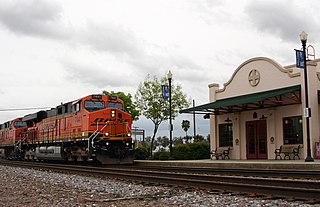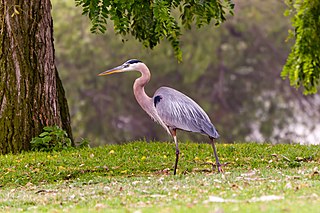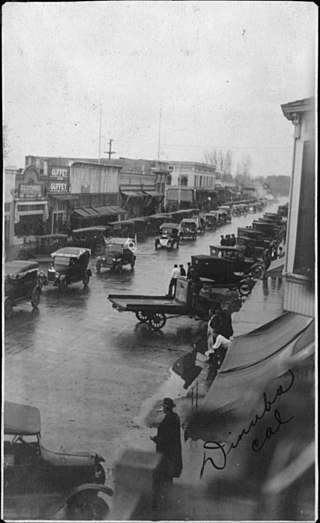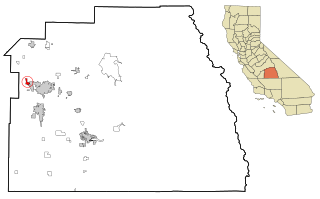
Tulare County is a county located in the U.S. state of California. As of the 2020 census, the population was 473,117. The county seat is Visalia. The county is named for Tulare Lake, once the largest freshwater lake west of the Great Lakes. Drained for agricultural development, the site is now in Kings County, which was created in 1893 from the western portion of the formerly larger Tulare County.

Sebastopol is a city in Sonoma County, in California with a recorded population of 7,521, per the 2020 U.S. Census.

Ione is a city in Amador County, California. As of the 2020 census the population is 5,141, which is a 35.1% decrease from the 2010 census. Once known as "Bedbug" and "Freeze Out," Ione was an important supply center on the main road to the Mother Lode and Southern Mines during the California Gold Rush.

Corcoran is a city in Kings County, California, United States. The population was 24,813, up from 14,458. Corcoran is located 17 miles (27 km) south-southeast of Hanford, at an elevation of 207 ft (63 m).

Lemoore is a city in Kings County, California, United States. Lemoore is located 7.5 miles (12 km) west-southwest of Hanford, at an elevation of 230 feet (70 m). It is part of the Hanford-Corcoran Metropolitan Statistical Area. The population was 24,531 at the 2010 Census. The California Department of Finance estimated that Lemoore's population was 26,725 on July 1, 2019.

South El Monte is a city in the San Gabriel Valley, in Los Angeles County, California, United States. At the 2010 census, the city had a population of 20,116, down from 21,144 at the 2000 census.

Buellton is a small city in Santa Barbara County, California, United States. It is located in the Santa Ynez Valley, 3 miles (4.8 km) west of Solvang. The population was 5,161 at the 2020 census, up from 4,828 at the 2010 census.

Alpaugh is a census-designated place (CDP) in Tulare County, California, United States. The population was 1,026 at the 2010 census, up from 761 at the 2000 census.

Cutler is a community and census-designated place (CDP) in Tulare County, California, United States. The population was 5,000 at the 2010 census, up from 4,491 at the 2000 census. The population as of 2019 was 5,214.

Dinuba is a city in Tulare County, California, United States. The population was 24,563 at the 2020 census, up from 21,453 at the 2010 census. It is part of the Visalia-Porterville metropolitan statistical area. The Alta District Museum is located in Dinuba in a restored railroad station; the museum has a collection of materials that illustrate local history.

Exeter is a city in Tulare County, California, United States. It is situated in the San Joaquin Valley near the foothills of the Sierra Nevada. The population was 10,321 at the 2020 census, down from 10,334 at the 2010 census.

Goshen is a census-designated place (CDP) near Visalia, in Tulare County, California, United States. The population was at 5,387 in the 2020 census, up from the 3,006 in the 2010 census. Until the twentieth century, Goshen was an island in a marsh at the edge of Tulare Lake, formerly the largest freshwater lake west of the Great Lakes until drained.

Lindsay is a city in Tulare County, California, United States. The population was 12,659 at the 2020 census. Lindsay is located southeast of Visalia and north of Porterville and is considered part of the Visalia-Porterville Metropolitan Area and the Porterville Urban Area by the United States Census Bureau.

Tulare is a city in Tulare County, California. The population was 68,875 per the 2020 census. It is located in the heart of the San Joaquin Valley, 8 mi (13 km) south of Visalia and 60 mi (97 km) north of Bakersfield. The city is named after the Tulare Lake, once the largest freshwater lake west of the Great Lakes.

Visalia is a city in the agricultural San Joaquin Valley of California. The population was 141,384 as per the 2020 census. Visalia is the fifth-largest city in the San Joaquin Valley, the 40th most populous in California, and 192nd in the United States. As the county seat of Tulare County, Visalia serves as the economic and governmental center to one of the most productive agricultural counties in the country.

Farmersville is a village in Montgomery County, Illinois, United States. The population was 689 at the 2020 census.

Princeton is a city in Scott County, Iowa, United States. The population was 923 at the time of the 2020 census.

Farmersville is a village in Jackson Township, Montgomery County, Ohio, United States. The population was 975 at the 2020 census. It is part of the Dayton Metropolitan Statistical Area.

Allensworth is an unincorporated community in Tulare County, California. Established by Allen Allensworth in 1908, the town was the first in California to be founded, financed, and governed by African-Americans.
Yettem is a census-designated place (CDP) in Tulare County, California. Yettem is located on California State Route 201 11 miles (18 km) north of Visalia. Yettem has a post office with ZIP code 93670. Yettem sits at an elevation of 348 feet (106 m). The 2010 United States census reported Yettem's population was 211.

























